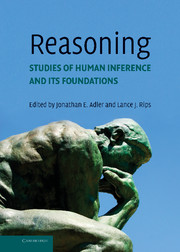Book contents
- Frontmatter
- Contents
- Preface
- List of Contributors
- Introduction: Philosophical Foundations
- PART I FOUNDATIONS OF REASONING
- PART II MODES OF REASONING
- Section 3 Deductive Reasoning
- Section 4 Induction
- Section 5 Dual and Integrative Approaches
- Section 6 Abduction and Belief Change
- Section 7 Causal and Counterfactual Reasoning
- 29 Causal Thinking
- 30 Causation
- 31 Propensities and Counterfactuals: The Loser That Almost Won
- Section 8 Argumentation
- PART II INTERACTIONS OF REASONING IN HUMAN THOUGHT
- Index
- References
31 - Propensities and Counterfactuals: The Loser That Almost Won
Published online by Cambridge University Press: 05 June 2012
- Frontmatter
- Contents
- Preface
- List of Contributors
- Introduction: Philosophical Foundations
- PART I FOUNDATIONS OF REASONING
- PART II MODES OF REASONING
- Section 3 Deductive Reasoning
- Section 4 Induction
- Section 5 Dual and Integrative Approaches
- Section 6 Abduction and Belief Change
- Section 7 Causal and Counterfactual Reasoning
- 29 Causal Thinking
- 30 Causation
- 31 Propensities and Counterfactuals: The Loser That Almost Won
- Section 8 Argumentation
- PART II INTERACTIONS OF REASONING IN HUMAN THOUGHT
- Index
- References
Summary
The question of how people think of things that could have happened but did not has attracted increasing interest among psychologists in recent years (J. T. Johnson, 1986; Kahneman & Miller, 1986; Kahneman & Tversky, 1982a; Landman, 1987; D. T. Miller, Turnbull, & MacFarland, 1990; Wells & Gavanski, 1989; Wells, Taylor, & Turtle, 1987). As philosophers have long known, the study of counterfactuals cannot be separated from a conception of causality, and an understanding of causality requires a conception of possibility and conditional probability. Counterfactual assertions rest on causal beliefs, and causal attributions invoke counterfactual beliefs, for example, about what would have happened in the absence of a putative cause. Some counterfactual assertions assign degrees of probability or plausibility to unrealized outcomes, many causal beliefs are probabilistic, and judgments of probability often draw on impressions of causal tendencies or propensities. The present article is concerned with a psychological analysis of this nexus of issues.
Our study began with an attempt to understand the psychology of assertions of the form “X almost happened,” which we call close counterfactuals. An important characteristic of such assertions is that they are not expressed as a conditional with a specified antecedent, as counterfactual conditionals are. The close counterfactual does not invoke an alternative possible world, but states a fact about the history of this world – namely, that things were close to turning out differently than they did.
- Type
- Chapter
- Information
- ReasoningStudies of Human Inference and its Foundations, pp. 639 - 651Publisher: Cambridge University PressPrint publication year: 2008



